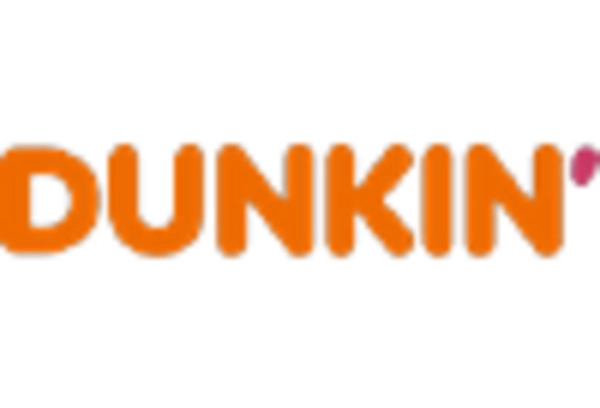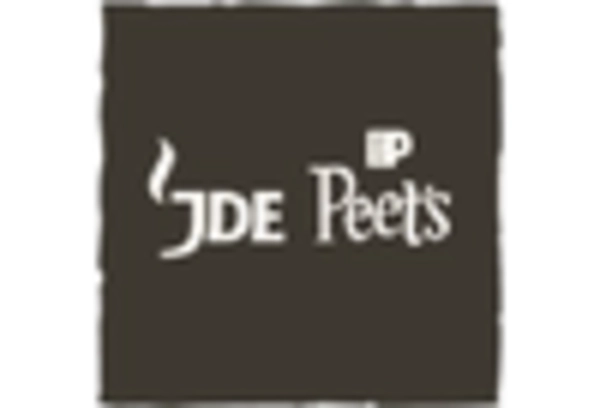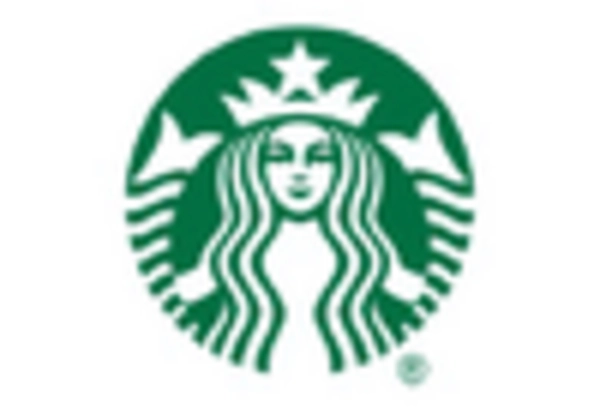Expansion of Coffee Culture
The expansion of coffee culture in North America is a significant driver of growth in the coffee market. Coffee consumption is increasingly viewed as a social experience, with consumers seeking out unique coffee shops and specialty brews. This cultural shift has led to a proliferation of artisanal coffee shops and cafes, contributing to a projected growth rate of 6% in the coffee shop segment by 2025. The coffee market is likely to benefit from this trend as consumers prioritize experiences over mere consumption. Additionally, the rise of coffee-related events and festivals further underscores the growing appreciation for coffee as a craft. As coffee culture continues to flourish, it is expected to drive innovation and diversification within the market, encouraging brands to explore new flavors and brewing techniques.
Rising Health Consciousness
The increasing awareness of health and wellness among consumers appears to be a pivotal driver in the coffee market. Many individuals are gravitating towards coffee as a healthier beverage option, particularly due to its antioxidant properties and potential health benefits. In North America, the demand for organic and specialty coffee has surged, with sales reaching approximately $5 billion in 2025. This trend indicates a shift in consumer preferences towards products perceived as healthier. Furthermore, the coffee market is witnessing a rise in demand for low-calorie and sugar-free options, reflecting a broader trend of health-conscious consumption. As consumers become more discerning about their dietary choices, the coffee market is likely to adapt by offering innovative products that align with these health trends.
Evolving Consumer Preferences
The coffee market is currently experiencing a notable shift in consumer preferences, particularly among younger demographics. Millennials and Generation Z are increasingly favoring unique flavors and artisanal blends, which has led to a rise in the popularity of specialty coffee shops. In North America, the specialty coffee segment is expected to account for over 50% of total coffee sales by 2025. This evolution in taste preferences indicates a growing demand for diverse coffee offerings, including cold brews, nitro coffee, and flavored varieties. The coffee market must adapt to these changing preferences by innovating and expanding their product lines to cater to the adventurous palates of younger consumers. As a result, brands that successfully tap into these evolving tastes are likely to gain a competitive edge in the market.
Sustainability and Ethical Sourcing
Sustainability and ethical sourcing practices are becoming increasingly critical in the coffee market. Consumers in North America are showing a strong preference for brands that prioritize environmentally friendly practices and fair trade sourcing. This trend is reflected in the growing sales of certified organic and fair trade coffee, which have seen a rise of approximately 15% in recent years. The coffee market is responding by implementing sustainable practices throughout the supply chain, from cultivation to packaging. Companies that embrace these values are likely to enhance their brand loyalty and attract environmentally conscious consumers. As sustainability becomes a key purchasing factor, the coffee market is expected to evolve, with more brands committing to transparent sourcing and eco-friendly initiatives.
Technological Advancements in Brewing
Technological innovations in brewing methods are significantly influencing the coffee market. The introduction of advanced brewing equipment, such as smart coffee makers and single-serve machines, has transformed the way consumers prepare their coffee at home. In North America, the market for coffee machines is projected to grow by approximately 8% annually, driven by the demand for convenience and quality. These advancements not only enhance the brewing experience but also cater to the growing trend of home brewing. The coffee market is likely to see an increase in sales of high-tech brewing devices, as consumers seek to replicate café-quality beverages in their own kitchens. This trend suggests that the integration of technology into coffee preparation will continue to shape consumer preferences and drive market growth.


















Leave a Comment